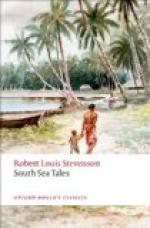Under the guidance of Taniera we were soon installed in what I believe to have been the best-appointed private house in Fakarava. It stood just beyond the church in an oblong patch of cultivation. More than three hundred sacks of soil were imported from Tahiti for the Residency garden; and this must shortly be renewed, for the earth blows away, sinks in crevices of the coral, and is sought for at last in vain. I know not how much earth had gone to the garden of my villa; some at least, for an alley of prosperous bananas ran to the gate, and over the rest of the enclosure, which was covered with the usual clinker-like fragments of smashed coral, not only coco-palms and mikis but also fig-trees flourished, all of a delicious greenness. Of course there was no blade of grass. In front a picket fence divided us from the white road, the palm-fringed margin of the lagoon, and the lagoon itself, reflecting clouds by day and stars by night. At the back, a bulwark of uncemented coral enclosed us from the narrow belt of bush and the nigh ocean beach where the seas thundered, the roar and wash of them still humming in the chambers of the house.
This itself was of one story, verandahed front and back. It contained three rooms, three sewing-machines, three sea-chests, chairs, tables, a pair of beds, a cradle, a double-barrelled gun, a pair of enlarged coloured photographs, a pair of coloured prints after Wilkie and Mulready, and a French lithograph with the legend: ‘Le brigade du General Lepasset brulant son drapeau devant Metz.’ Under the stilts of the house a stove was rusting, till we drew it forth and put it in commission. Not far off was the burrow in the coral whence we supplied ourselves with brackish water. There was live stock, besides, on the estate—cocks and hens and a brace of ill-regulated cats, whom Taniera came every morning with the sun to feed on grated cocoa-nut. His voice was our regular reveille, ringing pleasantly about the garden: ’Pooty—pooty—poo—poo— poo!’
Far as we were from the public offices, the nearness of the chapel made our situation what is called eligible in advertisements, and gave us a side look on some native life. Every morning, as soon as he had fed the fowls, Taniera set the bell agoing in the small belfry; and the faithful, who were not very numerous, gathered to prayers. I was once present: it was the Lord’s day, and seven females and eight males composed the congregation. A woman played precentor, starting with a longish note; the catechist joined in upon the second bar; and then the faithful in a body. Some had printed hymn-books which they followed; some of the rest filled up with ‘eh—eh—eh,’ the Paumotuan tol-de-rol. After the hymn, we had an antiphonal prayer or two; and then Taniera rose from the front bench, where he had been sitting in his catechist’s robes, passed within the altar-rails, opened his Tahitian Bible, and began to preach from notes. I understood




